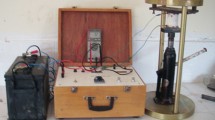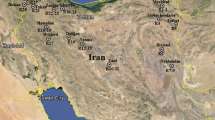Abstract
The purpose of this study is to investigate the index-mechanical properties of igneous rocks by using electrical resistivity method. To this end, electrical resistivity, index (P-wave velocity, dry density, and porosity), and uniaxial compressive strength values of 48 different igneous rock samples (plutonic, volcanic, and pyroclastic) were measured in the laboratory. Simple regression analysis was performed between index-mechanical properties compatible with the values of electrical resistivity. A strong exponential correlation was obtained between the electrical resistivity and porosity values of the igneous rock samples used in this study. On the other hand, a strong logarithmic correlation was found between the electrical resistivity values and other index-mechanical properties. The electrical resistivity method can be used as a non-destructive method to assess the engineering properties of rocks where it is hard to get regular-shaped rock samples either from an outcrop or a historical building.




Similar content being viewed by others
References
Boyce RE (1968) Electrical resistivity of modern marine sediments from the Bering Sea. J Geophys Res 73:4759–4766. https://doi.org/10.1029/JB073i014p04759
Kermabon A, Gehin C, Blavier P (1969) A deep-sea electrical resistivity probe for measuring porosity and density of unconsolidated sediments. Geophys 34:554–571. https://doi.org/10.1190/1.1440031
Keller GV (1974) Engineering applications of electrical geophysical methods: Proceedings of Conference on Subsurface Exploration for Underground Excavation and Heavy Construction, Henniker, New Hampshire, pp 128–143
Matsui T, Park SG, Park MK, Matsuura S (2000) Relationship between electrical resistivity and physical properties of rocks. ISRM International Symposium, Melbourne, Australia, pp 19–24
Khairy H, Harith ZZT (2011) Influence of pore geometry, pressure and partial water saturation to electrical properties of reservoir rock: measurement and model development. J Petrol Sci Eng 78:687–704. https://doi.org/10.1016/j.petrol.2011.07.018
Rahman T, Lebedev M, Zhang Y, Barifcani A, Iglauer S (2017) Influence of rock microstructure on its electrical properties: an analysis using x-ray microcomputed tomography. Energy Procedia 114:5023–5031. https://doi.org/10.1016/j.egypro.2017.03.1651
Llera F, Sato M, Nakatsuka K, Yokoyama H (1990) Temperature dependence of the electrical resistivity of water-saturated rocks. Geophys 55(5):576–585. https://doi.org/10.1190/1.1442869
Mostafa M, Afify N, Gaber A, Abozid E (2003) Electrical resistivity of some basalt and granite samples from Egypt. Egyption J Solids 26:25–32
Zhang W, Sun Q, Zhu S, Hao S (2017) The effect of thermal damage on the electrical resistivity of sandstone. J Geophys Eng 14:255–261. https://doi.org/10.1088/1742-2140/aa5a22
Zhang W, Sun Q, Hao SQ, Yang L (2016) Experimental study of the effect of thermal damage on resistivity and mechanical properties of sandstone. Acta Geodyn Geomater 13(2):185–192. https://doi.org/10.13168/AGG.2015.0056
Lü C, Sun Q (2018) Electrical resistivity evolution and brittle failure of sandstone after exposure to different temperatures. Rock Mech Rock Eng 51(2):639–645. https://doi.org/10.1007/s00603-017-1351-7
Gokhale CS (1999) Studies on strength, deformation and electrical resistivity behaviour of certain sedimentary rocks. PhD Thesis, Indian Institute of Technology.
Sun Q, Zhu S, Xue L (2015) Electrical resistivity variation in uniaxial rock compression. Arabian J Geosci 8:1869–1880. https://doi.org/10.1007/s12517-014-1381-3
Kate J, Sthapak A (1995) Engineering behaviour of certain Himalayan rocks. The 35th US Symposium on Rock Mechanics (USRMS), Nevada, pp 783–788
Kahraman S, Alber M (2006) Predicting the physico-mechanical properties of rocks from electrical impedance spectroscopy measurements. Int J Rock Mech Min Sci 43:543–553. https://doi.org/10.1016/j.ijrmms.2005.09.013
Kahraman S, Ogretici E, Fener M, Yeken T (2006) Predicting the physico-mechanical properties of igneous rocks from electrical resistivity measurements. EUROCK, Belgium, pp 557–560
Kahraman S, Yeken T (2010) Electrical resistivity measurement to predict uniaxial compressive and tensile strength of igneous rocks. Bull Mater Sci 33:731–735. https://doi.org/10.1007/s12034-011-0137-x
Su O, Momayez M (2017) Indirect estimation of electrical resistivity by abrasion and physico-mechanical properties of rocks. J Appl Geophys 143:23–30. https://doi.org/10.1016/j.jappgeo.2017.05.006
İnce İ (2018) Determination of index-strength properties of pyroclastic rocks by electrical resistivity method. OHU J Eng Sci 7(2):772–780. https://doi.org/10.28948/ngumuh.444789
Sertçelik İ, Kurtuluş C, Sertçelik F, Pekşen E, Aşçı M (2018) Investigation into relations between physical and electrical properties of rocks and concretes. J Geophys Eng 15(1):142–152. https://doi.org/10.1088/1742-2140/aa87ca
Renibar S, Nasab SK (2019) Determination of uniaxial compressive strength of granite rock samples using electrical resistivity measurement: NDT. Conference Proceedings, EAGE-GSM 2nd Asia Pacific Meeting on Near Surface Geoscience and Engineering, 2019: 1–5. https://doi.org/10.3997/2214-4609.201900452
Wu G, Wang K, Zhao M, Nie Z, Huang Z (2019) Analysis of damage evolution of sandstone under uniaxial loading and unloading conditions based on resistivity characteristics. Adv Civ Eng 2019:9286819. https://doi.org/10.1155/2019/9286819
Yin D, Xu Q (2020) Comparison of sandstone damage measurements based on non-destructive testing. Mater 13(22):5154. https://doi.org/10.3390/ma13225154
Yin D, Xu Q (2021) Investigating the damage evolution of sandstone using electrical impedance spectroscopy. Int J Rock Mech Min Sci 144:104817. https://doi.org/10.1016/j.ijrmms.2021.104817
Wang K, Li X, Huang Z, Zhao M (2021) Experimental study on acoustic emission and resistivity response of sandstone under constant amplitude cyclic loading. Adv Mater Sci Eng 2021:6637200. https://doi.org/10.1155/2021/6637200
Wang K, **a Z, Li HZ, X, (2021) Damage evolution of sandstone under constant-amplitude cyclic loading based on acoustic emission parameters and resistivity. Adv Mater Sci Eng 2021:7057183. https://doi.org/10.1155/2021/7057183
Streickeisen A (1979) Classification and nomenclature of volcanic rock lomprophyres, corbanatites and millitic rocks. Geol 7:331–335
Schmid R (1981) Descriptive nomenclature and classification of pyroclastic deposits and fragments: recommendations of the international union of geological sciences subcommission on the systematics of igneous rocks. Geol 9:41–43
ISRM (2007) The Complete ISRM Suggested Methods for Rock Characterization, Testing and Monitoring: 1974–2006. (in Ulusay R, Hudson J Eds), International Society for Rock Mechanics, Commission on Testing Methods, Ankara, Turkey
ASTM D2938 (1986) Standard test method for unconfined compressive strength of intact rock core specimens. Annual book of ASTM standards, American Society for Testing and Materials, West Conshohocken
TS EN-12407 (2019) Natural stone test methods - Petrographic examination. Turkish Standards Institution, Ankara
NBG (1985) Engineering Geology and Rock Engineering: Norwegian Group of Rock Mechanics. Fornebu, Norway
ISRM (1979) Suggested methods for determining the uniaxial compressive strength and deformability of rock materials. Int J Rock Mech Min Sci 16:135–140
Fener M (2011) The effect of rock sample dimension on the P-wave velocity. J Nondestr Eval 30:99–105. https://doi.org/10.1007/s10921-011-0095-7
Acknowledgements
The author is grateful to the Onur Marble enterprises for their permission, help, and convenience during the samples collection. Two anonymous reviewers are gratefully acknowledged for their helpful suggestions and constructive comments on the manuscript.
Author information
Authors and Affiliations
Corresponding author
Ethics declarations
Conflict of Interest
The author declares no competing interests.
Additional information
Publisher's Note
Springer Nature remains neutral with regard to jurisdictional claims in published maps and institutional affiliations.
Rights and permissions
About this article
Cite this article
İnce, İ. Predicting Index-Mechanical Properties of Igneous Rock Using Electrical Resistivity Method. Mining, Metallurgy & Exploration 39, 531–539 (2022). https://doi.org/10.1007/s42461-022-00554-8
Received:
Accepted:
Published:
Issue Date:
DOI: https://doi.org/10.1007/s42461-022-00554-8




